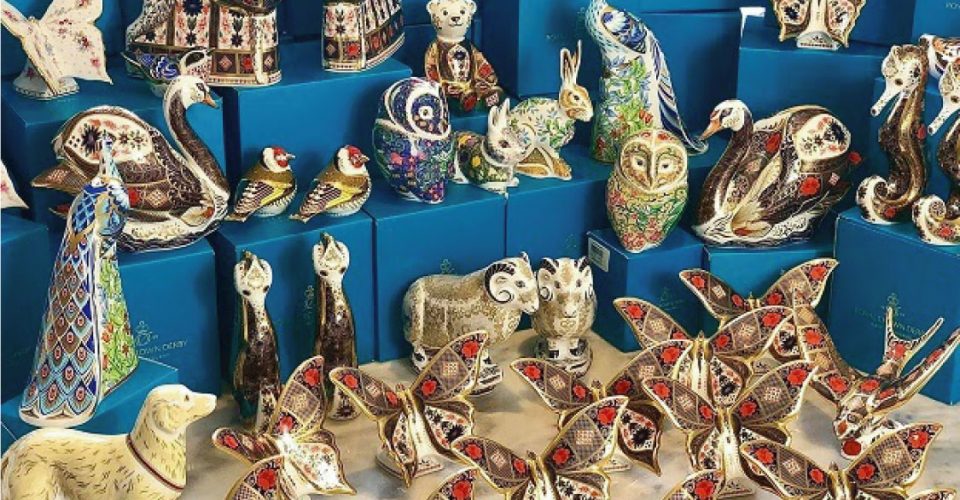Royal Crown Derby: Fine Porcelain for a Luxurious Home
Porcelain is white vitrified pottery, that´s translucent and is typically made of clay such as kaolin. Unlike other types of pottery, porcelain is white and almost translucent, and it’s tough. It’s made by heating up at temperatures between 1,200 and 1,400 °C. The clay becomes strong through vitrification, developing a glass-like appearance. Generally, porcelain comes in three types: hard-paste, soft-paste and bone china.
Like any form of art, porcelain will never cease to have its dedicated audience. While most households around the world have at least some porcelain pieces at home, some people appreciate the beauty of porcelain more than others. Anyone who loves displaying beautiful ornaments or who loves owning and using stunning porcelain tableware should own high-quality Royal Crown Derby fine bone china. Whether you are buying pieces for yourself or you are looking for an unforgettable present for a loved one, Crown Derby porcelain can elevate the style in your home by adding sophistication and luxury.
There are many things that make the Crown Derby porcelain pieces with their unique designs, elegancy and sophistication such a worthy possession. The company comes with a rich background, an exciting and remarkable history, some of the best craftsmen, and the world’s finest porcelain pieces. But first, let’s learn something about the history of porcelain to understand how Crown Derby has come such a long way.

A Brief History of Porcelain
Porcelain has been evolving for a long period in China, somewhere between 2000 and 1200 years ago. Some historians believe that it has been discovered more than 2,000 years ago, because the first evidence of porcelain pieces has been traced back to the Eastern Han Dynasty, from 206 BC to 220 AD. Nevertheless, the art form has continued evolving through time, and it wasn´t until the Tang Dynasty, which lasted from 618 to 907 AD that it became widely used. So many consider this to be the first evidence of porcelain as we know it today.
Known as “Tzu” in China, porcelain was used for producing teacups, plates, vases, sculptures, etc. The name we use today, “porcelain”, is considered to be first used by Marco Polo, describing a type of pottery he saw in China as “porcellana”, meaning cowrie shell, because it resembles the surface of the shell. In English, porcelain is also oftentimes referred to as china, for obvious reasons.

The Arrival in Europe
In the 16th century, the Portuguese started carrying Chinese porcelain directly to Europe. As a matter of fact, porcelain became known to the people of Europe when the Dutch captured a Portuguese ship, which carried thousands of porcelain pieces. Since then, porcelain has gained huge popularity amongst Europeans, with millions of pieces coming to Europe. Which in turn made it necessary for Europeans to start to try to produce their own china.
The main properties that make porcelain different from others are translucency and whiteness, which occur because it’s heated at such a high temperature. Furthermore, porcelain has almost zero porosity, which means that it’s impermeable. This in turn makes it very hygienic, which is why it continues to be the most common material used for tableware. In other words, porcelain is highly resistant.
Bone China
Composed of kaolin, feldspathic material and bone ash, the so-called bone china is a type of porcelain that was developed in the attempts to start porcelain production in Europe. Namely, when English potters couldn’t find the right formula to create hard-paste porcelain, they discovered that bone ash added to their soft-paste porcelain mixtures gave it strength. Although fine and translucent, bone china is the strongest, most chip-resistant porcelain.
This fine porcelain, also referred to as English porcelain, was first developed in a factory near East London in 1748. And not long after, many English porcelain manufacturers popped up, among which Crown Derby especially gained popularity.

The Precious Crown Derby Porcelain
From its establishment, Crown Derby has been creating breathtaking bespoke unique pieces for luxury private residences, as well as hospitality venues. Throughout their history, they have served some of the major hotels, restaurants and other venues around the world, as well as distinguished clients, including Royal Families. The company comes with an impressive history, which started in the second half of the 18th century, more precisely in the early 1750s, when the production of Derby porcelain started.
An English enameller, or a painter of porcelain, William Duesbury (1725-1786), founded the Derby Porcelain which later on become Royal Crown Derby, an important name in the world of porcelain. He noted the quality porcelain being produced in Derby, by Andrew Planche, son of a Huguenot refugee, who begun the first china works in Derby. This collaboration resulted in the highest quality china.
The quality and beauty of their porcelain pieces attracted many extremely skilled craftsmen, and shortly after it was founded, the company could count on some of the best amongst them. By 1773, Derby porcelain gained wide recognition, when they opened a London showroom.
Royal Crown Derby china was so highly regarded, that earlier, in 1761, for the coronation of King George III the company created a commemorative piece. Later on, King George III granted the factory the honour of incorporating a crown into their back stamp. Much later, in 1890, Queen Victoria further strengthened this tie of the company with royalty, by granting it the title “The Royal Crown Derby Porcelain Company”.
Royal Crown Derby collectables come in a wide variety of beautifully designed items, such as picture frames, paperweights, vases, lamps, jars, candelabras, figurines and other decorative elements made of fine bone china, while Royal Crown Derby dinnerware offers some of the most beautiful pieces, used around the world by high-end hospitality establishment. Since then, they’ve remained one of the oldest manufacturers of bone china, which has their entire production based exclusively in the UK.

